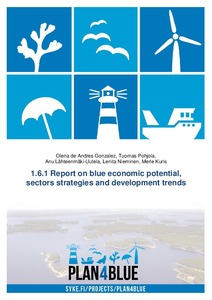Report on blue economic potential, sectors strategies and development trends
Olena de Andres Gonzalez; Tuomas Pohjola; Anu Lähteenmäki-Uutela; Lenita Nieminen; Merle Kuris
https://urn.fi/URN:NBN:fi-fe2021042826019
Tiivistelmä
The Blue economy concept and the Blue Growth agenda as a set of strategic objectives, offer principles and guidance to identify blue economy potential for the cross-border Maritime Spatial Planning (MSP) processes. Coastal regions and areas are recognised as having economic growth potential that exceeds the levels of inland regions, which indicates that the sea basin withholds valuable strategic resources in aiming for sustainable growth in the Plan4Blue (P4B) project area in Finland and Estonia.This report outlines the current status of the selected blue economic businesses in the Plan4Blue (P4B) project area in Finland and Estonia and depicts some possible development trends, based on their nine-years past development. This analysis of the blue industry development is primarily based on Orbis Europe database and national statistics databases. The sectoral development is illustrated with graphs presenting turnover and employment figures development and some future trends in the P4B project area in Finland and Estonia separately. All key sectors show positive long-term development, tourism industry showing the strongest future growth potential in terms of expected number of employees. In terms of productivity, the energy sector and marine construction sector are the highest performers out of the selected blue industry sectors in the P4B project area.
This report builds on the current state analysis to outline and summarise some key strategic visions, aims and objectives for the future, communicated by a wide range of blue economy stakeholders in the Baltic Sea Region (BSR) and globally, that is the EU, OECD, UN and focal blue industries that have all published visions and guidelines or strategic objectives and policy papers to pursue future growth in a sustainable manner. The strategies for the key blue industries call for cross-border and crosssectoral development in the Baltic Sea region to achieve blue growth effectively. In order to maintain and improve the health of the Baltic Sea and wellbeing in the coastal areas requires strategic goal setting for short, medium and long-term. The blue economy industries are interconnected and interdependent, which should be seen as an advantage in the strategy formation and differentiation in the markets to achieve economic growth in the future.
Kokoelmat
- Rinnakkaistallenteet [27094]
